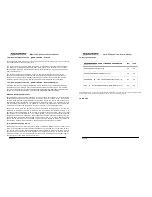
FRS QUAD-LINK Service Manual
2004 Edition 1
Mar
in FRS Quad-Link Service Manual
Page 12
2004 Edition 1
12.0: Rear Suspension Set-up - QUAD-Link FRS - Preload
These bikes are fitted with either a Fox or an X-Fusion rear air shock unit. The air pressure
in the shock determines the spring rate.
The correct ‘sag’ can be found using the sliding ‘o’ ring fitted to the shaft of the shock pis-
ton. Slide the ‘o’ ring against the shock body. Then gently sit on the bike in your normal
riding position. Carefully dismount and measure the distance the ‘o’ ring has moved away
from the shock body.
The optimum distance for the QUAD system is 12mm displacement from the ‘o’ ring
back up to the shock body. If there is less than 12mm fit a shock pump and release air
pressure. Conversely if there is greater than 12mm of travel, fit the shock pump and in-
crease air pressure. Repeat the ‘sag’ test until the 12mm displacement is achieved.
12.1: Rear Suspension Set-up - QUAD-Link FRS - Rebound Damping
When the damper unit is being compressed, this is known as the compression stroke. As
the suspension unit recovers from compression back towards its full length, this is called
the re-bound stroke. All the shocks fitted as standard to Marin QUAD-LINK FRS bikes have
factory set compression damping, and manually adjustable rebound damping.
Rebound Damping adjustment.
This adjustment fine-tunes the speed at which the rear wheel returns to its normal ride
height after hitting a bump. The adjuster is coloured red and is found on the rear damper
unit. An arrow marked slower indicates the direction to turn the dial to slow down the re-
bound speed of the suspension. To demonstrate the effect of this, turn the adjuster to its
slowest setting. Press down on the saddle to compress the suspension, then release the
load. You will see that the suspension recovers very slowly to its original position.
Repeat the above with the adjuster turned to the fastest setting and you will see the
difference immediately the load is released. We recommend the optimum setting is to
adjust the re-bound damping to be as slow as possible, but not so slow that the normal
ride height is not recovered. On very rough terrain, if the rear of the bike becomes
progressively lower as more bumps are hit then the re-bound damping is set too slow. On
the other hand if the bike feels choppy and not plush then the re-bound damping is too
fast. A bit of trial and error is needed to get the exact setting. Riders may choose to
change their settings, while stationary, depending on the terrain they are riding.
13.0: Front Suspension Set-up
When you have set the rear suspension, follow the Owners Manual to fine tune the front
forks. It is important to achieve a balance between the front and rear of the bike. In time,
you will be able to make these small adjustments required to optimise the way in which
the front and rear suspension work together over all types of terrain. In order to achieve
maximum traction, we recommend that it is best to run a small amount of initial “sag” on
the front forks, in the same way as on the rear.
Table of Contents:
1.0
Figure 1, Exploded Diagram: Rear Shock Assembly.
1.1
Parts List: Rear Shock Assembly
2.0
Removal of Rear Shock
3.0
Figure 2, Exploded Diagram: Rear Suspension Assembly
3.1
Parts List: Rear Suspension Assembly
4.0
Removal of Swinging Arm
5.0
Removal of Links
6.0
Figure 3, Exploded Diagram: 1 Piece Link Assembly
6.1
Parts List: 1 Piece Link Assembly
7.0
Figure 4a,4b,4c,4d. Illustration of KP5AX Bearing Extraction
7.1
Extracting KP5AX Bearings from 1 Piece Links
8.0
Figure 5, Illustration of KP5AX Bearing Installation
8.1
Parts List: Assembly of KPAX Bearings for Installation
8.2
Installation of KP5AX Bearings
8.3
Figure 6, Diagram of Centre Spacer Installation
8.4
Parts List: Assembly of Centre Spacer Installation
8.5
Installation of Centre Spacer and Remaining KP5AX Bearing
9.0
Figure 7, Illustration of Assembly of Links to Main Frame
9.1
Fitting of Link Assemblies
10.0
Fitting of Swinging Arm
11.0
Fitting of Rear Shock
12.0
Rear Suspension Set-up: Pre-Load
12.1
Rear Suspension Set-up: Rebound Damping
13.0
Front Suspension Set-up
14.0
Torque Settings
15.0
Notes
Marin FRS Quad-Link Service Manual
Page 1
2004 Edition 1
For use on white and light colored backgrounds
For use on black and dark colored backgrounds
LOGOS MAY NOT BE ALTERED IN ANY WAY. If you have any questions or special considerations please contact
."3*/#*,&4t"UUO5PN(PSUPO71#SBOEJOH%FTJHOt 5&-YUt&."*-UPNH!NBSJOCJLFTDPN
AUTOHRIZED BRAND LOGOS : 2/1/09
MARIN BIKES : CORPORATE BRAND LOGOTYPE
MARIN BIKES : BOLD STROKE LOGOTYPE & BEAR HEAD ICON
For use on white and light colored backgrounds
For use on black and dark colored backgrounds
For use on white and light colored backgrounds
For use on black and dark colored backgrounds
LOGOS MAY NOT BE ALTERED IN ANY WAY. If you have any questions or special considerations please contact
."3*/#*,&4t"UUO5PN(PSUPO71#SBOEJOH%FTJHOt
5&-YUt&."*-UPNH!NBSJOCJLFTDPN
AUTOHRIZED BRAND LOGOS : 2/1/09
MARIN BIKES : CORPORATE BRAND LOGOTYPE
MARIN BIKES : BOLD STROKE LOGOTYPE & BEAR HEAD ICON
For use on white and light colored backgrounds
For use on black and dark colored backgrounds
Page 1

























